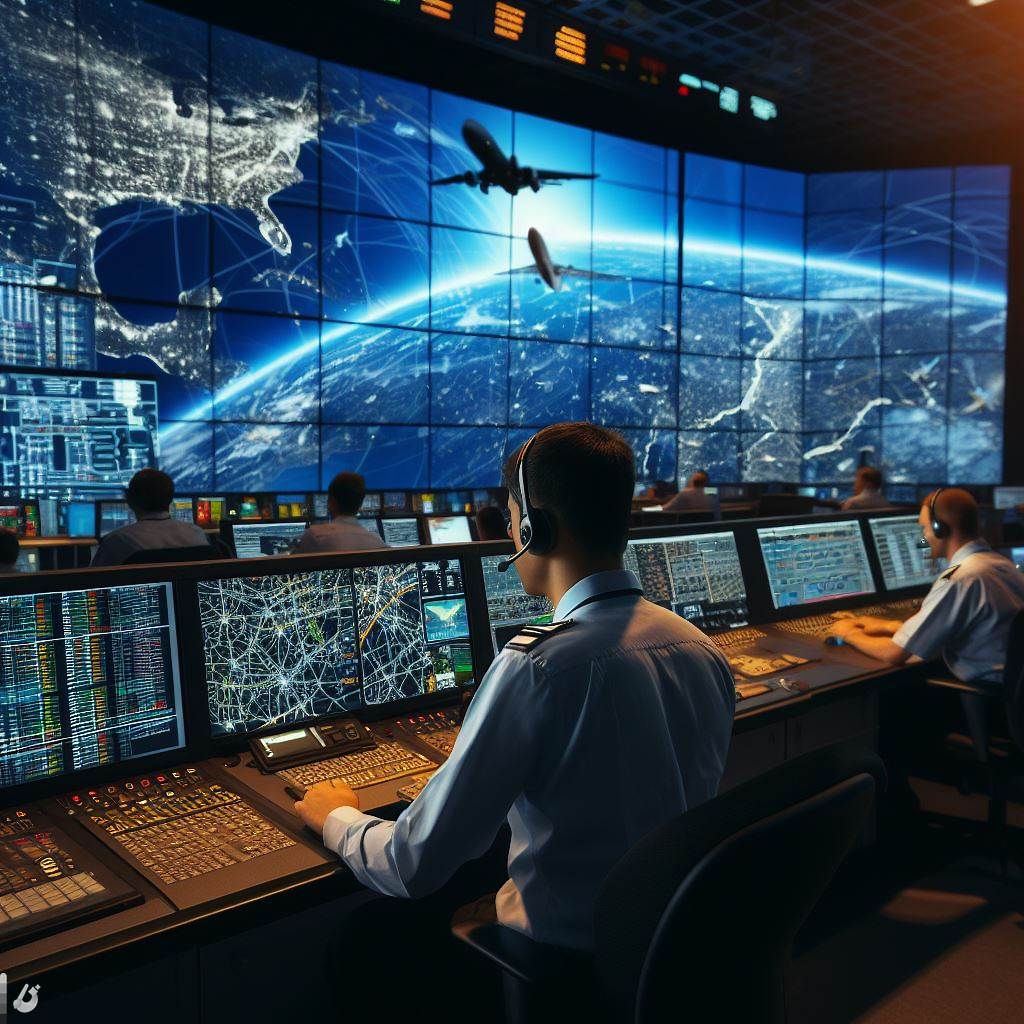Introduction
In the vast expanse of the skies, air traffic control or flight management stands sentinel, orchestrating aircraft movements with precision.
United States airspace relies on this intricate system to navigate the delicate balance between safety and efficiency.
Ensuring seamless aviation operations, flight management plays a pivotal role in averting potential disasters and mitigating congestion.
It’s a dynamic dance of coordination and communication that keeps the skies safe and the flow of air traffic smooth.
As planes crisscross the heavens, air traffic controllers, armed with advanced technology, guide them through the invisible highways of the sky, epitomizing the epitome of aerial management.
The importance of air traffic control cannot be overstated, as it remains the unsung hero behind the scenes, safeguarding lives and keeping the aviation industry soaring to new heights.
Early Beginnings of Air Traffic Control
Early forms of air traffic control in the early 1900s
In the early 1900s, as aviation began to take flight, the need for some form of air traffic control became apparent.
However, at this early stage, the concept of air traffic control was still in its infancy.
First attempts to regulate air traffic with signal lights and flags
One of the first attempts to regulate air traffic was through the use of signal lights and flags.
Airfields and landing strips employed individuals who would use flags or lanterns to direct incoming and outgoing aircraft. While this method was rudimentary, it provided a basic level of control.
Formation of the first air traffic control organizations
As the aviation industry continued to grow, the need for more formalized air traffic control organizations became evident.
In the 1920s, the formation of the first air traffic control organizations occurred.
The first of these organizations was the Air Mail Act of 1925, which required flight management services for mail-carrying aircraft.
This act led to the establishment of Airway Traffic Control centers to ensure safe navigation of airmail planes.
Following the Air Mail Act, in 1936, the Bureau of Air Commerce formed the first full-scale flight management system.
This system was initially focused on providing traffic separation services for commercial aviation. The system utilized a network of towers equipped with radio communication to relay instructions to pilots.
During this period, air traffic controllers were known as “airway traffic control specialists” and were responsible for guiding pilots along specific flight routes, ensuring safe distances between aircraft, and providing weather updates.
Throughout the 1940s and 1950s, the flight management system underwent significant advancements, including the introduction of radar technology.
Radar allowed controllers to track aircraft positions more accurately, improving safety and efficiency.
In 1956, the Federal Aviation Agency was established, centralizing flight management responsibilities under one agency. This transition marked a significant milestone in the history of air traffic control in the United States.
Transform Your Career Today
Unlock a personalized career strategy that drives real results. Get tailored advice and a roadmap designed just for you.
Start NowSince then, air traffic control has continued to evolve, incorporating modern technologies such as computerized systems and satellite navigation.
Today, the Federal Aviation Administration (FAA) oversees the flight management system in the United States, ensuring the safe and efficient movement of aircraft.
The early beginnings of flight management in the United States can be traced back to the early 1900s when simple methods like signal lights and flags were used to regulate air traffic.
With the growth of aviation, the formation of flight management organizations became necessary.
The establishment of the Air Mail Act in 1925 and the Bureau of Air Commerce in 1936 played vital roles in the development of a more structured air traffic control system.
Advancements in technology, such as radar, further enhanced safety and efficiency.
Today, the FAA plays a central role in overseeing the flight management system, ensuring the continued safe operation of air travel.
Read: Safety Protocols & Procedures in U.S. Air Traffic Control
Development of Air Traffic Control Systems
Introduction of radio communication for air traffic control
- In the early 1920s, radio communication emerged as a vital tool in air traffic control.
- Radio communication facilitated real-time communication between pilots and ground controllers.
- This breakthrough enabled controllers to provide guidance and instructions to pilots during flights.
- Prior to radio communication, pilots relied on visual signaling and ground-based signals.
- The introduction of radio communication significantly improved the safety and efficiency of air traffic control.
Creation of air traffic control centers and control towers
- In the 1930s, air traffic control centers and control towers were established throughout the United States.
- These centers and towers became key operational hubs for managing air traffic.
- Air traffic control centers were responsible for overseeing a vast region of airspace.
- Control towers were situated at airports, providing localized control within the immediate vicinity.
- Operators in control towers directed aircraft movements on the ground and during take-off and landing.
- The creation of these facilities marked a significant milestone in flight management history.
Advancements in radar technology and its impact on air traffic control
- In the 1940s, radar technology revolutionized air traffic control capabilities.
- Radar systems allowed controllers to detect and track aircraft positions accurately.
- This breakthrough provided enhanced surveillance of airspace, especially in adverse weather conditions.
- Improved radar technology enabled controllers to effectively manage air traffic flow.
- The integration of radar systems with other flight management tools further enhanced safety and efficiency.
- Radar remains a critical component of modern flight management systems.
In this section, we explore the evolution of United States’ traffic management systems.
We delve into the introduction of radio communication, creation of control centers and towers, and radar advancements impacting traffic management.
During the early 1920s, radio communication became vital for guiding pilots in real-time. Before this, pilots relied on visual and ground-based signals, limiting effectiveness.
The introduction of radio communication significantly enhanced safety and efficiency.
In the 1930s, centers and towers were established across the United States, becoming crucial hubs. Centers oversaw vast airspace, while towers provided localized control at airports.
These facilities marked a significant milestone in traffic management.
In the 1940s, radar revolutionized traffic control. Radar systems accurately tracked aircraft positions, even in adverse weather.
This improved airspace surveillance immensely, enabling effective traffic flow management. Radar remains a critical component in modern systems.
Advancements in radar technology were complemented by integrating other traffic control tools. Combined with radar, these tools enhanced safety and efficiency.
Today, systems continue evolving, incorporating technologies like satellite navigation and data communication networks.
In essence, the evolution of traffic management systems in the United States has seen significant advancements.
Showcase Your Business Today
Reach thousands of readers actively exploring professional services. Publish your business profile and grow your audience now.
Publish NowFrom radio communication to control center and tower establishment, and radar integration, each milestone has improved safety and efficiency.
As technology evolves, flight systems will undergo further transformations to meet growing air travel demands.
Continuing Evolution of Air Traffic Control
The transition from traditional radar to digital systems
The history and evolution of air traffic control in the United States have seen significant advancements over the years.
One crucial aspect of this evolution has been the transition from traditional radar systems to digital ones.
Radar technology has played a vital role in flight management since its inception.
However, with the advent of digital systems, flight management has become more efficient and accurate.
Digital radar systems provide controllers with enhanced capabilities, such as improved surveillance and more precise tracking of aircraft.
These systems allow for better coordination and communication between controllers and pilots.
The transition from traditional radar to digital systems has also resulted in increased safety and reduced delays.
Digital radar allows for faster and more accurate detection of potential conflicts, enabling controllers to take proactive measures to ensure safe and efficient aircraft separation.
Integration of GPS technology for more precise guidance
Another important advancement in air traffic control is the integration of Global Positioning System (GPS) technology.
GPS has revolutionized navigation by providing accurate positioning and time information globally.
Incorporating GPS into flight management systems has allowed for more precise guidance of aircraft.
Pilots can now follow predetermined flight paths with increased accuracy, reducing the likelihood of deviations and potential conflicts.
Controllers can also utilize GPS data to monitor and manage aircraft movement more efficiently.
Furthermore, GPS technology enables more flexible routing options, optimizing flight paths and reducing fuel consumption.
It has significantly contributed to the overall efficiency of air traffic control operations, resulting in cost savings for both airlines and passengers.
Implementation of advanced automation tools in air traffic control
In addition to radar and GPS upgrades, the implementation of advanced automation tools has been instrumental in the evolution of air traffic control.
Automation has the potential to streamline processes, improve efficiency, and enhance overall safety.
One such tool is the use of computer-based decision support systems. These systems can analyze vast amounts of data in real-time, assisting controllers in making informed decisions.
By providing accurate and timely information, these tools help manage complex situations and optimize airspace utilization.
Another significant automation tool is the development of collaborative decision-making platforms.
These platforms facilitate airlines, airports, and stakeholders in effective communication and coordination, ensuring seamless operations.
They facilitate collaborative decision-making processes, reducing delays, and improving overall operational efficiency.
The integration of artificial intelligence and machine learning algorithms also holds immense potential for flight management
These technologies can continuously learn and adapt to changing conditions, improving predictive capabilities and enabling proactive decision-making.
In essence, the evolution of air traffic control in the United States has witnessed a transition from traditional radar to digital systems, integration of GPS technology, and implementation of advanced automation tools.
These advancements greatly improved operational efficiency, safety, and precision, benefiting the overall performance of controlling traffic in the air.
With continuous improvements, the future of air traffic control holds even more promising possibilities for a seamless and efficient aviation system.
Read: Challenges & Rewards of Being an Air Traffic Controller in the U.S.

Challenges and Innovations in Modern Air Traffic Control
Issues related to increasing air traffic and congestion
As air traffic continues to grow, the United States faces several challenges in managing the increasing congestion in its airspace.
The growing travel needs mandate an upgraded, efficient system ensuring safety and minimizing delays in controlling traffic.
The existing infrastructure is struggling to keep up with the rising demand, resulting in congestion and air traffic delays.
The Federal Aviation Administration (FAA) has been working on innovative solutions to address these challenges.
Introduction of NextGen technology for more efficient operations
To cope with the increasing air traffic, the FAA has embarked on a significant modernization effort known as Next Generation Air Transportation System (NextGen).
NextGen aims to transform the aging radar-based system into a satellite-based system, improving the safety, efficiency, and capacity of air traffic control.
It utilizes advanced technologies such as GPS, digital communication, and advanced automation to enable more precise aircraft tracking, optimized routing, and improved situational awareness for controllers and pilots.
By implementing performance-based navigation and data communications, NextGen reduces delays and enhances fuel efficiency, benefiting both the airlines and the environment.
Collaborative decision-making and data-sharing for enhanced safety
Another key innovation in modern air traffic control is the adoption of collaborative decision-making and data-sharing.
Traditionally, decision-making in flight management was centralized and controlled by air traffic controllers.
Showcase Your Business Today
Reach thousands of readers actively exploring professional services. Publish your business profile and grow your audience now.
Publish NowHowever, with the increased complexity and demands of air traffic, a collaborative approach has become essential.
By involving all stakeholders, including airlines, pilots, and airports, in decision-making processes,
better-informed decisions can be made to optimize airspace utilization and minimize delays.
Sharing real-time data among all parties allows for more accurate situational awareness,
helping to predict and prevent potential conflicts or hazards.
The integration of automation and advanced algorithms further supports collaborative decision-making.
Computer systems can analyze large amounts of data and assist in generating optimal solutions
by considering numerous factors such as weather conditions, aircraft performance, and air traffic demand.
This not only improves safety but also enhances operational efficiency and reduces the workload of air traffic controllers.
In general, modern air traffic control in the United States faces challenges due to increasing air traffic and congestion.
Through innovative initiatives such as NextGen technology and collaborative decision-making, the FAA is addressing these challenges and working towards a more efficient and safe flight management system.
By embracing technological advancements and fostering collaboration among stakeholders, the United States continues to strive for excellence in managing its airspace and ensuring the smooth operation of air traffic for years to come.
Read: The Impact of Technology on Air Traffic Control in the USA
Future of Air Traffic Control in the United States
Air traffic control in the United States has come a long way since its inception.
As technology continues to advance, the future of air traffic control looks promising. This chapter will explore the potential developments that lie ahead.
Exploration of Unmanned and Autonomous Aircraft Management
One aspect of the future of air traffic control involves the exploration of unmanned and autonomous aircraft management.
With the rise of drones and other unmanned aerial vehicles, it is crucial to develop systems that can effectively control and manage their movement in the airspace.
Unmanned aircraft management will require innovative software and communication systems to ensure safe and efficient integration of these vehicles with manned aircraft.
The development of reliable collision avoidance systems and advanced air traffic management software will be essential.
Furthermore, autonomous aircraft management will play a significant role. As technology progresses, we can expect to see more autonomous passenger and cargo aircraft.
These aircraft will require sophisticated automation systems that can navigate through airspace, communicate with other aircraft and ground controllers, and make decisions regarding flight path adjustments.
Potential Impact of Emerging Technologies like Artificial Intelligence
Another significant aspect of the future of air traffic control is the potential impact of emerging technologies like artificial intelligence (AI).
AI can transform and enhance systems, boosting efficiency, reliability, and resilience in managing traffic.
AI systems analyze real-time data, identify patterns, and create predictive models for informed decision-making in controlling traffic.
This can help controllers in anticipating potential conflicts, reducing delays, and optimizing flight routes.
Additionally, AI-powered automation can assist controllers in handling routine tasks, freeing up their time to focus on critical decision-making.
It can also enhance collaboration between pilots and air traffic controllers, improving communication and situational awareness.
Continual Efforts to Improve Efficiency, Safety, and Environmental Sustainability
Efforts to improve efficiency, safety, and environmental sustainability in air traffic control will always be at the forefront of developments in the field.
Future systems must handle growing air travel demand, prioritize safety, and minimize delays effectively.
This will require advancements in infrastructure, such as the implementation of NextGen systems, which can enable more precise routing and reduce congestion.
Safety remains a paramount focus, with ongoing efforts to improve and elevate future systems for enhanced security.
Improved surveillance technologies, such as the Automatic Dependent Surveillance-Broadcast (ADS-B), will provide more accurate and comprehensive tracking of aircraft, allowing controllers to have better situational awareness and prevent potential conflicts.
Furthermore, environmental sustainability will be a crucial focus.
Systems must support greener tech, optimizing flight paths for less fuel and emissions, aiding the adoption of eco-friendly practices.
In review, the United States envisions tremendous potential for shaping the future of aviation management.
Exploring unmanned and autonomous aircraft management, harnessing the power of emerging technologies like AI, and continual efforts to improve efficiency, safety, and environmental sustainability will shape the systems of tomorrow.
Read: Salary & Benefits Overview: Air Traffic Controllers in the USA
Conclusion
Recap of the history and evolution of air traffic control
Air traffic control in the United States has come a long way since its inception.
Since the 1920s, it has evolved and improved, transitioning from humble origins to a modern, technology-driven system.
Importance of air traffic control for the continued growth of aviation in the United States:
Without effective air traffic control, the growth and safety of aviation in the United States would be severely hindered.
Managing airspace, ensuring safe flight operations, and minimizing accidents are crucial roles played in aviation safety.
Final thoughts on the future prospects of air traffic control
The promising future of aviation sees advancements in technology, ensuring increased efficiency, safety, and capacity enhancements.
Innovations such as artificial intelligence and unmanned aircraft systems will shape the future of flight control and propel the aviation industry forward.
Showcase Your Business Today
Reach thousands of readers actively exploring professional services. Publish your business profile and grow your audience now.
Publish NowIn the end, the history and evolution of flight control in the United States demonstrate its vital role in the growth and safety of aviation.
Looking forward, the future promises advancements and holds great potential for the continued growth of this field.
[E-Books for Sale]
The Big Book of 500 High-Paying Jobs in America: Unlock Your Earning Potential
$19.99 • 500 High-Paying Jobs • 330 pages
Explore 500 high-paying jobs in America and learn how to boost your career, earn more, and achieve success!
See All 500 High-Paying Jobs of this E-Book
1001 Professions Without a Degree: High-Paying American Jobs You Can Start Now
$19.99 • 1001 Professions Without a Degree • 174 pages
Discover 1001 high-paying jobs without a degree! Unlock career tips, skills, and success strategies for just $19.99!




